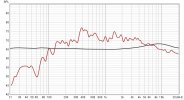-
WANTED: Happy members who like to discuss audio and other topics related to our interest. Desire to learn and share knowledge of science required. There are many reviews of audio hardware and expert members to help answer your questions. Click here to have your audio equipment measured for free!
You are using an out of date browser. It may not display this or other websites correctly.
You should upgrade or use an alternative browser.
You should upgrade or use an alternative browser.
Why does DIRAC completely remove bass response (KEF R3 + sub + minidsp flex)
- Thread starter Geertidow
- Start date
Looks like there is quite the messiness still with the crossover. But imma ignore that for a while.
Imma ask you to tune the gain of these filters using pink noise from the listening position, apply only negative gain, increase it till the offending frequencies disappear.

I noticed there are some very early reflections happening at these frequencies

Imma ask you to tune the gain of these filters using pink noise from the listening position, apply only negative gain, increase it till the offending frequencies disappear.
I noticed there are some very early reflections happening at these frequencies
- Thread Starter
- #24
This is what I do to check early reflections. I use frequency dependent windowing (in IR Windows), 10 cycles for 100Hz to 300Hz and 5 cycles for 300Hz and up.
Only use negative gain filters to treat areas strategically, always tune the gain by listening to pink noise. Under 100Hz what we measure is more or less what we hear, but above that that's not the case anymore.
You can also measure different listening positions and see which ones offer the least amount of peaks and dips. This makes a DRAMATIC difference in sound quality.



Only use negative gain filters to treat areas strategically, always tune the gain by listening to pink noise. Under 100Hz what we measure is more or less what we hear, but above that that's not the case anymore.
You can also measure different listening positions and see which ones offer the least amount of peaks and dips. This makes a DRAMATIC difference in sound quality.
Attachments
Dips are not really a big deal but in my experience but peaks are literal distortion.
- Thread Starter
- #28
If I remove a cabinet that 100 hz peak is mostly removed but I still have to check if I can actually head it. I used the trimming of peaks up to about 900 hz.Dips are not really a big deal but in my experience but peaks are literal distortion.
However, does DIRAC do this for me or is it less optimal?
If I remove a cabinet that 100 hz peak is mostly removed but I still have to check if I can actually head it. I used the trimming of peaks up to about 900 hz.
However, does DIRAC do this for me or is it less optimal?
Dirac only adjusts (besides the phase correction) the average amplitude response of all your measurements to the target curve you provide.
However, I don’t think these measurements represent how people actually hear above 100Hz, Dirac does miracles when it comes to the subbass but response wise above 100Hz it does more harm than good with good speakers.
You need to surgically treat issues caused by the location of the speaker in the room, and leave the issues caused by the location of the listener alone.
Last edited:
- Thread Starter
- #30
And can you say anything about the 80 hz crossover?Dirac only adjusts (besides the phase correction) the average amplitude response of all your measurements to the target curve you provide.
However, I don’t think these measurements represent how people actually hear above 100Hz, Dirac does miracles when it comes to the subbass but response wise above 100Hz it does more harm than good with good speakers.
You need to surgically treat issues caused by the location of the speaker in the room, and leave the issues caused by the location of the listener alone.
And can you say anything about the 80 hz crossover?
the 100Hz crossover seem to perform the best out of the measurements you send me, if you can somehow solve that 100Hz dip then that's even better.
plug the port of the speakers if you want to use crossover at 100Hz. 12db/oct BW high-pass and 24db/oct LR low-pass should yield a perfect LR 24db/oct crossover at 100Hz with the port plugged.
D
Deleted member 48726
Guest
Dirac only adjusts (besides the phase correction) the average amplitude response of all your measurements to the target curve you provide.
However, I don’t think these measurements represent how people actually hear above 100Hz, Dirac does miracles when it comes to the subbass but response wise above 100Hz it does more harm than good with good speakers.
You need to surgically treat issues caused by the location of the speaker in the room, and leave the issues caused by the location of the listener alone.
What do you base those claim of?
What do you base those claim of?
I remember it boosting an SBIR null and making it sound pretty awful, I learned a lot during the last year and a half. Dirac support helped me by advising me to adjust the target curve not to boost that dip.

Huge (-10 dB) dip between 200Hz and 300Hz in my room.
Hello, I have this huge 200Hz to 300Hz dip in my room and I don't really know why or what to do about it. The speakers are measured on this forum, they're flat so I would rule out the speakers. they're rear ported and placed in a bookcase; However, there is more than enough room for the...
 www.audiosciencereview.com
www.audiosciencereview.com
Last edited:
D
Deleted member 48726
Guest
So it's your own experience with Dirac and not general.I remember it boosting an SBIR null and making it sound pretty awful, I learned a lot during the last year and a half.

Huge (-10 dB) dip between 200Hz and 300Hz in my room.
Hello, I have this huge 200Hz to 300Hz dip in my room and I don't really know why or what to do about it. The speakers are measured on this forum, they're flat so I would rule out the speakers. they're rear ported and placed in a bookcase; However, there is more than enough room for the...www.audiosciencereview.com
So it's your own experience with Dirac and not general.
If you think so.
You're obviously not going to find an article from Dirac advising people not to use their products with good performing speakers.
D
Deleted member 48726
Guest
No, not if I think so. It is, in fact, your own single experience you use as a generalization. -Isn't it?If you think so.
You're obviously not going to find an article from Dirac advising people not to use their products with good performing speakers.
Good performing speakers also benefit from EQ when placed in a room as the room color the sound. A speaker with a flat response (anechoic) will probably respond better to EQ than a speaker with wildly varying response. So if anything I would say that a good speaker is better to EQ than a "bad" one. Bad here meaning a speaker with a response that's all over the place.
You can find a lot of sources on the internet from people with much more higher qualifications than I am saying you should not EQ a speaker with a flat on-axis response and smooth directivity above the transition frequency. Something that DIRAC does.
You don't have to listen to me per say.
You don't have to listen to me per say.
D
Deleted member 48726
Guest
Why would you not want to correct for room response and what are the negative effect you (and lots of sources on the internet) claim?You can find a lot of sources on the internet from people with much more higher qualifications than I am saying you should not EQ a speaker with a flat on-axis response and smooth directivity above the transition frequency. Something that DIRAC does.
You don't have to listen to me per say.
olegtern
Member
- Joined
- Sep 23, 2020
- Messages
- 87
- Likes
- 100
Dirac use a massive of 9 (as I remember) measurements, and if they are done correctly from many random spots in the listening area, a speaker with a flat on-axis response and smooth directivity would measure flat (with some HF decline, but Dirac also has decline in target curve).You can find a lot of sources on the internet from people with much more higher qualifications than I am saying you should not EQ a speaker with a flat on-axis response and smooth directivity above the transition frequency. Something that DIRAC does.
Similar threads
- Replies
- 5
- Views
- 1K
D
- Replies
- 27
- Views
- 4K
- Replies
- 17
- Views
- 942
- Replies
- 8
- Views
- 1K
- Replies
- 1
- Views
- 633


